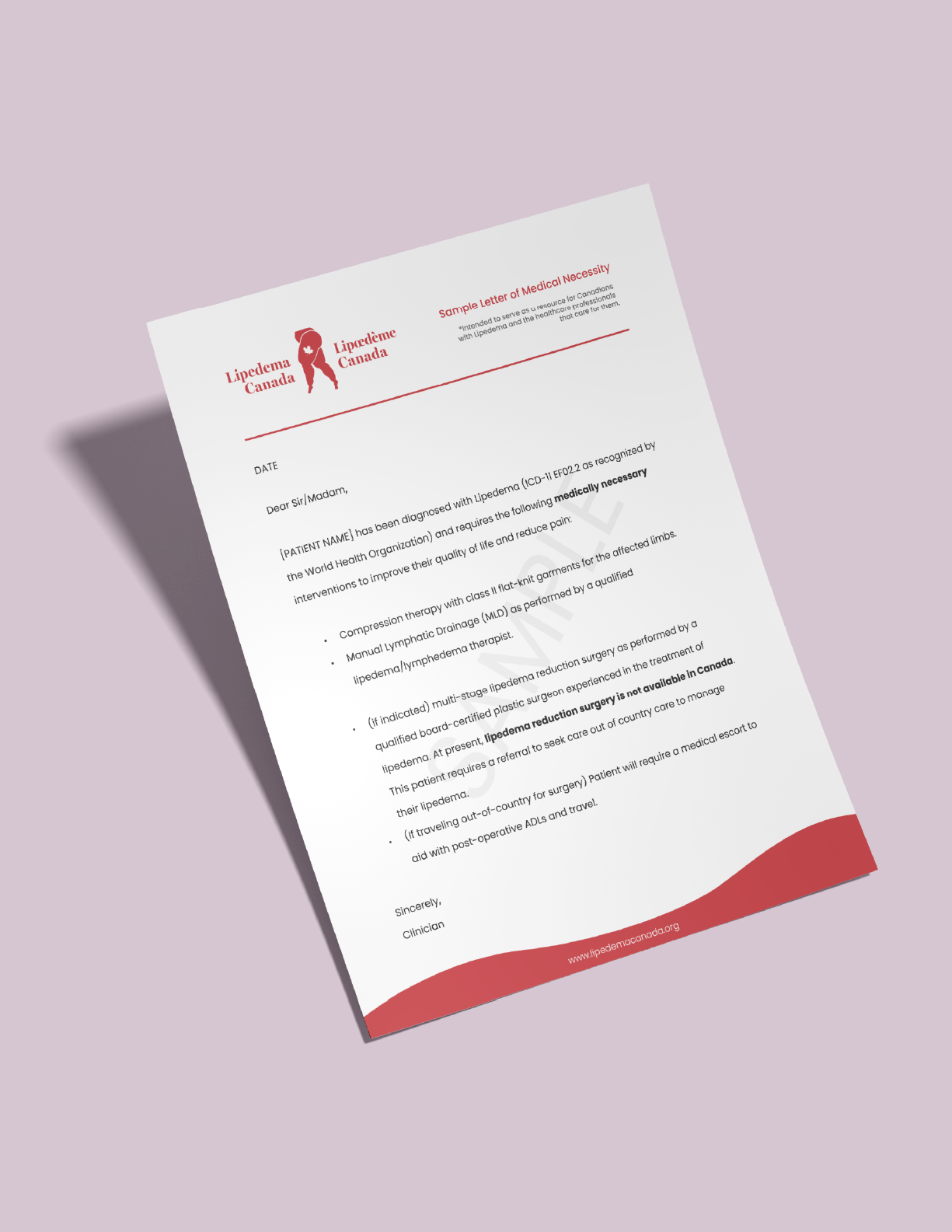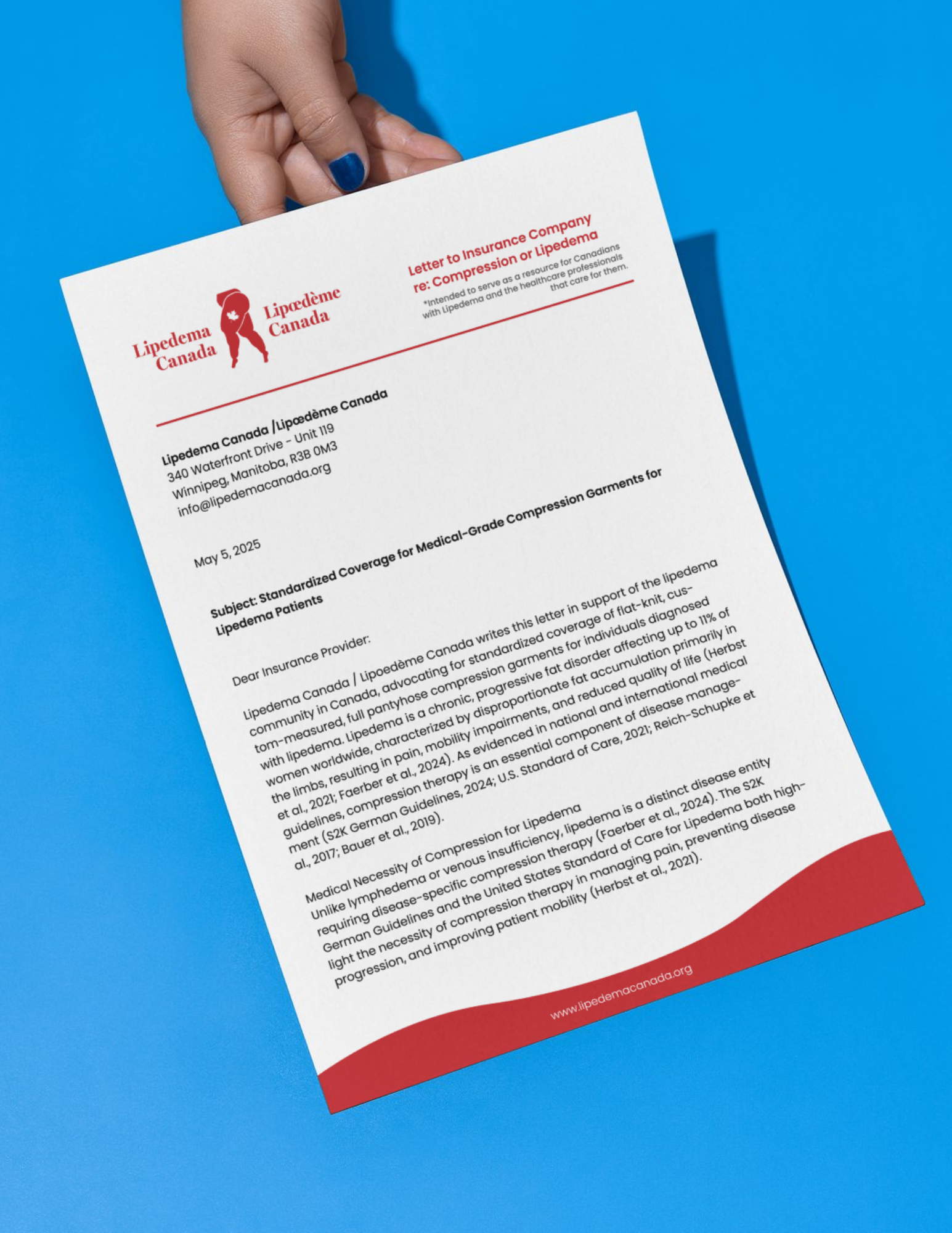For people with Lipedema
This informative brochure provides a broad overview of lipedema. It serves as an excellent resource for individuals seeking to understand the condition.
Click below to order printed brochures.
Click below to download the Lipedema Canada Patient brochure.
A helpful tool to bring along to your healthcare provider, outlining the basics for a lipedema diagnosis letter. This can prove useful for submitting claims to your private insurance or for claiming medical expenses on your tax filing with the Canada Revenue Agency.
Our sample letter of medical necessity helps to take the mystery out of what information is required for lipedema. This tool can serve as a guide for your care provider when they write a letter of support for lipedema patients.

Click below to download the Sample Letter of Medical Necessity.
This letter supports insured benefits coverage for medical-grade compression garments for lipedema patients. It educates Canadian insurance providers on lipedema’s distinct medical needs, emphasizing the necessity of flat-knit, custom-measured compression as standard care, and advocates for standardized, equitable coverage to reduce financial barriers and improve patient outcomes.
Using This Letter to Appeal a Denial:
If your insurance claim is denied, include this letter in your appeal to explain why flat-knit, custom-made compression garments are medically necessary for lipedema. It outlines why cheaper, off-the-shelf options are not appropriate, helping your insurer understand the disease-specific requirements and improve your chances of approval.

Click below to download
Letter to Insurance companies re: compression coverage for lipedema
Claiming medical expenses for out-of-pocket lipedema surgeries can be stressful. We have tried to make it a little easier with our tax filing tips.
Check out our helpful tax tips guide for a review of how to prepare and file your medical expenses related to out-of-pocket lipedema surgery.
Make sure to click the link below to download the sample expense spreadsheet to help keep everything organized.
Managing lipedema requires a multifaceted approach involving lifestyle modifications, medical interventions, and self-care practices. Patients maintain a healthy diet, exercise, wear compression garments, and utilize self-massage techniques for lymphatic draining. Regular consultations with healthcare professionals are vital for effective management.
Below are a list of helpful resources for managing your lipedema.
Conservative Measures for Lipedema:
Conservative measures for managing and treating lipedema focus on reducing symptoms and improving quality of life. These measures include:
Compression Therapy: Wearing flat-knit custom measured compression garments can help reduce swelling and improve lymphatic flow. Graduated compression stockings or bandages are commonly used. Class II 30-40 mmHg full pantyhose covering from the toes to the bellybutton are the recommendation for lipedema management.
Manual Lymphatic Drainage (MLD): This specialized massage technique can help stimulate the lymphatic system and reduce swelling. MLD is often provided by physiotherapists, massage therapists, nurses, or occupational therapists trained in lipedema and lymphedema care by an accredited program.
Exercise: Low-impact exercises such as walking, swimming, or cycling can help improve circulation and lymphatic flow. A physical therapist can provide guidance on suitable exercises. The goals are to get the lymphatic system moving, take care of your joints if you are hypermobile, and build strength to help combat extra weight.
Anti-Inflammatory Diet: Keto, RAD (rare adipose diet), low carb, or mediterranean ways of eating can help maintain a healthy weight and reduce inflammation.
Weight Management: While lipedema is not caused by obesity, maintaining a healthy weight through diet and exercise can help reduce the strain on the lymphatic system.
Psychological Support: Living with lipedema can be challenging, so counselling or support groups can be beneficial in managing the emotional impact of the condition.
It’s important to consult with a healthcare professional before starting any new treatment regimen, as they can provide personalized recommendations based on individual needs.
Surgical Treatment for Lipedema:
Surgical treatment (Lipedema Reduction Surgery – LRS) typically involves non-cosmetic liposuction, which aims to remove excess fat deposits in affected areas. Lipedema Reduction Surgery can be a useful tool to reduce pain, improve mobility, and improve quality of life for lipedema patients.
The best compression is the compression you can wear.
There are several things to consider before beginning compression therapy to manage your lipedema symptoms.
Compression can be a very challenging part of lipedema management.
The more advanced the stage, the harder it is to get well-fitting garments, and the contribution of pain, tenderness, mobility issues, and high cost of custom garments adds challenge.
This, in combination with poor fit and high cost, often means poor adherence to compression therapy and therefore, poor long term management. This tool can provide relief of some of the pain, especially the touch, as well as manage swelling in the limbs. Compression therapy is one of a list of conservative management strategies and can be used along with others for optimized relief of lipedema symptoms.
There are several different kinds on the market.
Circular knit: offers different angles of stretchiness and are suitable for various body shapes. It stretches along both length and width.
Flat Knit: offers stretch in two directions, and has a seam up the back of the leg. When fitted appropriately, they are less likely to roll or create creases on the skin which can cause further issues with lymphatic drainage, a tourniquet, and other skin issues.
Inelastic: Made from non-stretch material, inelastic garments mimic bandage wrapping techniques, providing firm support.
Micro Massaging: These garments utilize textured knit material to micro massage the lymphatics, promoting fluid movement.
Nighttime Compression: Designed for overnight wear, these thicker padded garments help reduce nightly swelling and break up fibrotic tissues.
Pneumatic Compression Pumps: Devices mimicking manual lymphatic drainage, aiding in pushing retained fluids towards the body’s core.
Those with lipedema should avoid circular knits. Custom flat knit garments are recommended for lipedema patients.
Manual lymphatic drainage (MLD) is a specialized massage technique using skin stretching and pumping, promoting lymphatic fluid movement. It provides temporary relief and decongestion to the tissue, complementing the effects of compression therapy. When used in conjunction with compression therapy, MLD can help manage pain, promote healing, and slow down progression.
MLD for lipedema is a regular and often daily part of conservative management. However, there are times when a person may benefit from being able to perform this task for themselves. Currently, MLD is not an insured service in the provinces and is often only given limited coverage by a private insurance benefit plan. There can be financial and geographical barriers to accessing MLD.
Check out this helpful video to learn the basics of self MLD.
Due to its proximity to the skin’s surface, dry brushing has emerged as a viable approach to address lipedema. This technique offers a range of benefits:
1. Enhancing venous blood flow
2. Activating the lymphatic system
3. Bolstering the immune system
4. Boosting surface circulation
5. Removing dead skin cells
6. Enhancing skin appearance for a revitalized feel
Dry brushing involves using a brush with soft bristles, whether with a handle or strap. The process is conducted without water, as wetness diminishes its efficacy. Employ long, gentle strokes, directing towards the heart and neck, starting from the feet upwards to the knees, groin, abdomen, and chest. Finally, brush the hands and arms towards the armpits.
When You Move, Lymph Moves – With lipedema or similar conditions, we know that we need to get moving and often. Whether you have a diagnosis or not, your self care is on you and the less you do now, the more your condition may progress, forcing you to spend time and money on care later.
We know the health benefits of exercise, yet many in this community cannot sustain traditional forms of exercise and are not regularly active. Severe symptoms and current health levels can make it too difficult or not worth the pain and suffering of recovering from it.
Low impact activity that does not increase lactic acid and can be short in duration is ideal. Start where you are at and do what you can now, any movement will help with increase lymph and blood flow.
A vibration plate creates a low-impact environment that stimulates the body and its systems in many ways, a physical experience that feels unique to each of us. General feedback is that it just feels good, making the pain, swelling and stress better. They are a fast, easy, and affordable way to get moving and help manage symptoms while gaining some exercise benefits at the same time.
Vibration plates make getting active possible as they are more tolerable and can be so simple to use when dealing with chronic issues.
What are the benefits? The same general benefits that moving and exercising will give you, a vibration machine is just an environment that makes getting moving, being active – easier, less strenuous while speeding up recovery. The benefits you can expect are related to how you use one, doing the best “moves” for your goals. Consistency like any activity will have the biggest impact.
Do not follow the basic instructions that are in the manual that come with the machine, chronic issues need a different approach. There is no one setting or program for any condition or symptoms. Like lipedema, vibration plates are not well known and commonly misunderstood.
What to do can be intimidating, especially if you don’t exercise regularly now. Get help to identify your goals and how to achieve them, find groups. experienced communities and other users for support, motivation, and other resources. As your experience and symptoms improve, so will your confidence in using and experimenting on you own.
There are 3 main reasons people are using a vibration plate:
Symptom Management
Increasing circulation and lymph can help many symptoms, and a few minutes standing or seated on a stool (poor mobility) can give relief, boost energy levels, and improve mobility. Remember that less is more – you are getting lots of micromovements; keep time and intensity minimal, use more often, as needed for symptoms.
Fitness/Weight Loss
For fitness gains you must do exercise positions or work up to them. Doing positions properly on a plate has less impact on joints and can fatigue you faster due to the increased movement/load on your muscles. Your trainer/therapist can help identify positions for your goals and progressing with them.
If you experience a rise in symptoms after exercise or have an elevated histamine response (common with POTS), take whatever precautions you would normally when starting a new activity (such as reducing intensity, taking antihistamines)
Lifestyle/Feel Good
We all want less stress and more down time; the machines are popular for how good they make you feel physically and mentally, boosting energy, and even lifting your mood. Users feel lighter, more mobile, even happier after a session. If you are moving and feeling better other things become more possible.
Vibration plates ARE NOT related to occupation/workplace vibration exposure. The use of similar terminology has contributed to mis-association and unwarranted concern. When searching the internet for “whole body vibration” or “vibrational exposure limit”, a mix of both occupational and vibration plate references appear.
Even researchers with a lack of understanding make assumptions without looking further to realize they are in no way the same thing. They have only researched a small range of the machines’ performance characteristics even though they have been available for over 50 years now. Do your own homework and rely less on uninformed/unexperienced opinions online.
Using proper positioning and durations, whole body vibration (WBV) exercise or therapy has been shown to be a safe, low impact activity that almost anyone can tolerate, even if you are unable to stand – there are always ways to modify use.
It makes movement easy, is kinder on your body, and reduces the necessary time spent using it.
Selecting the “right” vibration plate
There is no “best” machine, no best setting, frequency, or program; it’s just like a treadmill or any other piece of equipment-it’s what you do on it, what you are ABLE to do and how often that drives change.
If a company or post you see states things like “this is the best frequency for…” or “that style of machine can be harmful…” they are trying to sell you something and are presenting a bias.
Forget what everyone else is saying, selecting the right plate is about your needs. Be honest with yourself in what you can and are willing to do physically. The machine isn’t going to do the work for you, you need to show up and be consistent using it. More features or higher cost doesn’t mean more benefits.
There are many different machines but all fall into 3 basic types of movement: oscillating, vertical and lateral with some models offering variations in combo or 2D/3D models. Each have their own feel and performance characteristics.
I recommend and prefer oscillating (pivotal/side alternating) for many reasons. It mimics how we walk, moving like a teeter totter. In my experience as a coach using all types, it is the most preferred for its natural feeling and affordability.
Machines with more than one movement are heavier and larger to accommodate the additional motors for each movement and extra features. The positions you perform, how you progress, and consistent use are the most important factors.
If just wanting to move and feel better, keep it simple. A basic oscillating machine will offer all you need. Modest operation and portability are best for use throughout the day or when travelling/working. One movement type means one motor and will be lighter, and more easily managed.
Like most equipment there are home/consumer and commercial/medical grade. A basic machine will suit most needs unless looking at high traffic use.
You are only limited by your imagination and your range of motion.
For online support with vibration plates please visit https://www.facebook.com/groups/vibrationforfatdisorders
– Thank you to Debby Pelletier for providing Lipedema Canada with this resource.

Debby discovered vibration plates when a bad knee and extra weight had her seeking alternatives to surgery. After 2 decades, 2 kids, 3 studios, and thousands of hands-on hours - clinics, gyms, and thousands of personal and professional users worldwide lean on Debby for training and self-care gear. She brings a simple, functional, and fun approach to her coaching and virtually supports users through online support groups. Deb uses a range of complimentary technologies combining light therapy, PEMF, compressions and other self-care tools for more optimal outcomes.
Limited understanding among clinicians regarding lipedema can lead to patients being corrected when they mention their condition and clinicians saying “lymphedema?” when in fact they mean lipedema. Understanding the differences between lipedema and lymphedema, as well as acknowledging that lipedema is not obesity, is crucial for providing appropriate care.
The International Classification of Diseases (ICD) is a standardized code set that enables healthcare professionals to record and share health data worldwide.
The World Health Organization updates the ICD periodically, and in 2019, Lipedema was recognized as a distinct disease entity with its own specific code in the 11th revision. Unfortunately, Canada cannot utilize this code yet and still relies on the ICD codes from the 9th and 10th revision, depending on the province. Lipedema Canada is currently seeking to include the coding for lipedema.
Below are the most commonly used ICD-10 codes at present (as reported by clinicians according to Lipedema Foundation):
ICD-11, which was adopted in 2019, includes a specific global ICD code for Lipedema for the first time:
Please note that as of May 2022, 35 countries have begun using ICD-11 codes, but each country is responsible for adopting and implementing the new codes in its own health system.
Furthermore, the Federal Institute for Drugs and Medical Devices (BfArM) in Germany has adopted several specific ICD-10 codes for Lipedema that are not used in the USA or Canada:
– E88.21 Lipedema, stage 1
– E88.22 Lipedema, stage 2
– E88.23 Lipedema, stage 3
– E88.24 Lipedema, other
(Sourced from Lipedema Foundation)
• Prescription for compression garments: flat-knit, class II custom measured is recommended for lipedema
• Certified Lymphedema/Lipedema Therapists for Manual Lymphatic Drainage and Combined Decongestive Therapy
• Registered dieticians to develop an anti-inflammatory eating plan
• Obesity medicine specialists to address any obesity related comorbidities
• Vascular specialists to assess for any vascular disease
• Qualified lipedema surgeons for specialized surgical options; consults to international board certified lipedema plastic surgeons are often made for those patients requiring surgery due to a lack of Canadian qualified providers at present
• Mental health professionals to provide support for mental health and quality of life challenges
• Support groups like Lipedema Canada on Facebook to connect with others for support
Our colleagues at the Lipedema Foundation have created and maintain a comprehensive database of scholarly articles on Lipedema. For the latest research, please visit the Legato Library.
This is a preliminary list of providers across the country that lipedema patients have identified have been helpful in their care.
We are developing a comprehensive list at this time. If you have suggestions for providers to be added to our list please email us at info@lipedemacanada.org
Click the button below to access our current list of providers.
Many patients exploring lipedema reduction surgery may seek surgeons outside of Canada due to the current scarcity of trained providers. Below, we present a directory of international lipedema surgeons curated by “Lipedema & Me”.
Lipedema Canada cannot verify the accuracy of information provided by external resources.
Disclaimer: Lipedema Canada is not a medical provider. This guide is for informational purposes only and is not intended to substitute for professional medical advice, diagnosis, or treatment. Seek the advice of your physician regarding a medical condition or treatment before undertaking any new healthcare regimen.